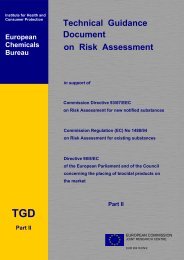Challenges of Regulation and Risk Assessment of Nanomaterials
Challenges of Regulation and Risk Assessment of Nanomaterials
Challenges of Regulation and Risk Assessment of Nanomaterials
Create successful ePaper yourself
Turn your PDF publications into a flip-book with our unique Google optimized e-Paper software.
Although the ISO framework for LCA is not specific for nanomaterials, it can be adapted to them. The<br />
main problem with LCA <strong>of</strong> nanomaterials <strong>and</strong> nanoproducts is the lack <strong>of</strong> data <strong>and</strong> underst<strong>and</strong>ing in<br />
certain areas. Major efforts are needed to fully assess potential risks <strong>and</strong> environmental impacts <strong>of</strong><br />
nanoproducts <strong>and</strong> materials (not just those related to LCA). There is a need for protocols <strong>and</strong><br />
practical methodologies for toxicology studies, fate <strong>and</strong> transport studies <strong>and</strong> scaling approaches.<br />
Further research is needed to gather missing relevant data <strong>and</strong> to develop user-friendly eco-design<br />
screening tools.<br />
Nanopolytox will address the following issues for nanomaterials over their life cycle: physical <strong>and</strong><br />
chemical characterization at the different stages; hazard characterization (human toxicity <strong>and</strong><br />
ecotoxicity) at the different stages; transformation, migration <strong>and</strong> release <strong>of</strong> nanomaterials included<br />
in products; environmental <strong>and</strong> biological fate <strong>of</strong> released nanomaterials; LCA analysis <strong>of</strong><br />
nanomaterials included in polymeric products; technological solutions for recycling <strong>and</strong> final<br />
treatment <strong>of</strong> polymer nanocomposites. S. Vázquez Campos, summarised the Nanopolytox workplan<br />
<strong>and</strong> timelines as well as its methodological aspects. The project will finalise in 2013.<br />
The presentation on Health, Safety, <strong>and</strong> Environment: <strong>Assessment</strong> Methods was made by D.<br />
Hristozov, including the comprehensive weight <strong>of</strong> evidence approach adopted within the ENPRA<br />
project. According to him, substantial limitations <strong>and</strong> uncertainties hinder the risk assessment (RA)<br />
<strong>and</strong> the lifecycle assessment (LCA) <strong>of</strong> engineered nanomaterials (ENMs), thus making difficult the<br />
implementation <strong>of</strong> appropriate risk management measures.<br />
Limitations <strong>of</strong> conventional RA lie mainly in the fields <strong>of</strong> hazard identification, dose-response<br />
relationship assessment <strong>and</strong> exposure assessment. Accordingly, there is an Increasing interest in<br />
development <strong>of</strong> complementary methodologies methodologies/models (as the XL<br />
Insurance Database Methodology, the precautionary matrix for synthetic nanomaterials, the ANSES<br />
System, the St<strong>of</strong>fenmanager Nano 1.0 <strong>and</strong> the NANOSAFER) <strong>and</strong> tools (weight <strong>of</strong> evidence (WoE),<br />
multi criteria decision analysis (MCDA), control b<strong>and</strong>ing, expert elicitation (EE)) for RA <strong>of</strong> ENMs. After<br />
making a review <strong>of</strong> them, the presenter concluded that none <strong>of</strong> the methodologies/models are<br />
intended to facilitate regulatory decision making, but instead mostly to serve as preliminary risk<br />
screening tools for use by SMEs <strong>and</strong> industry. There is indeed a need for quantitative risk assessment<br />
approach supporting near-term regulatory decisions.<br />
On the other side, although LCA is usually applied to matured technologies, there is a general trend<br />
toward an earlier adoption <strong>of</strong> LCA, indeed LCA <strong>of</strong> nanotechnology <strong>and</strong> nanoproducts can provide an<br />
opportunity for precautionary action in order to prevent or minimize potential impact to human<br />
health <strong>and</strong> the environment <strong>and</strong> can add supplementary environmental information to support<br />
decisions on the regulation <strong>of</strong> certain nanomaterials or nanoproducts. However few LCA studies on<br />
nanotechnologies have been published <strong>and</strong> whereas the ISO 14040 framework is appropriate, a<br />
number <strong>of</strong> issues need to be addressed as the lack <strong>of</strong> inventory data: (i.e. data about nanomaterial<br />
releases during manufacturing, use <strong>and</strong> disposal stages are not available) <strong>and</strong> how to correlate the<br />
nanomaterials releases with the characterization factors/ environmental indicators used within the<br />
LCA framework.<br />
Actually RA <strong>and</strong> LCA procedures are complementary. Indeed, although LCA is readily applicable to<br />
nanoproducts, the methodology faces limitations when addressing the toxicity <strong>of</strong> ENMs released<br />
throughout their life cycle, which is a strength <strong>of</strong> the RA. Both LCA <strong>and</strong> risk assessment are costly<br />
exercises, integration <strong>of</strong> RA <strong>and</strong> LCA (i.e. a pragmatic screening approach combining the use <strong>of</strong> LCA,<br />
risk assessment <strong>and</strong> scenario analysis) holds promise to support a more holistic nanotechnological<br />
assessment that will allow better underst<strong>and</strong>ing <strong>of</strong> the environmental <strong>and</strong> health impacts <strong>and</strong> the<br />
economic <strong>and</strong> social benefits <strong>of</strong> the nanoproducts. Clearly understood <strong>and</strong> communicated benefits<br />
18








